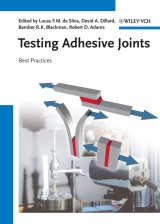Details

Testing Adhesive Joints
Best Practices1. Aufl.
|
115,99 € |
|
| Verlag: | Wiley-VCH |
| Format: | |
| Veröffentl.: | 25.03.2013 |
| ISBN/EAN: | 9783527647057 |
| Sprache: | englisch |
| Anzahl Seiten: | 468 |
DRM-geschütztes eBook, Sie benötigen z.B. Adobe Digital Editions und eine Adobe ID zum Lesen.
Beschreibungen
Joining techniques such as welding, brazing, riveting and screwing are used by industry all over the world on a daily basis. A further<br> method of joining has also proven to be highly successful: adhesive bonding. Adhesive bonding technology has an extremely broad range<br> of applications. And it is difficult to imagine a product - in the home, in industry, in transportation, or anywhere else for that matter - that<br> does not use adhesives or sealants in some manner. The book focuses on the methodology used for fabricating and testing adhesive and bonded joint specimens. The text covers a wide range of test methods that are used in the field of adhesives, providing vital information for dealing with the range of adhesive properties that are of interest to the adhesive community. With contributions from many experts in the field, the entire breadth of industrial laboratory examples, utilizing different best practice techniques are discussed. The core concept of the book is to provide essential information vital for producing and characterizing adhesives and adhesively bonded joints.
MANUFACTURE OF QUALITY SPECIMENS <br> Preparing Bulk Specimens by Hydrostatic Pressure<br> Preparing Bulk Specimens by Injection<br> Preparing Bulk Specimens by Pouring <br> Preparing Lap Joints with Flat Adherends <br> SimpleMethods for the Preparation of Single Lap Joints Specimens<br> Preparing Thick Adherend Shear Test Specimens <br> Modified Thick Adherend Shear Test <br> Preparing Butt Joints <br> Preparing Napkin Ring Specimens <br> Preparing T Joint Specimens <br> Preparing Flexible-to-Rigid Peel Specimens <br> Preparing Specimens for Fracture Properties: Double Cantilever Beam and Tapered Double Cantilever Beam <br> Preparing Bonded Wood Double Cantilever Beam (DCB)<br> Specimens <br> Modified Arcan Test <br> <br> QUASI-STATIC CONSTITUTIVE AND STRENGTH TESTS <br> Quasi-Static Testing of Bulk Tensile Specimens<br> Uniaxial and Bulk Compression <br> Quasi-Static Testing of Bulk Compression on Flat Specimens<br> Iosipescu (V-Notched Beam) Test <br> Arcan (V-Notched Plate) Test <br> Quasi-Static Testing of Butt Joints in Tension <br> Shear Properties of Adhesives Measured by Napkin Rings and Solid Butt Joints in Torsion <br> Quasi-Static Testing of Thick Adherend Shear Test Specimens <br> Modified Thick Adherend Shear Test <br> Quasi-Static Testing of Lap Joints <br> Modified Arcan Test <br> Pin-and-Collar Test Method <br> <br> QUASI-STATIC FRACTURE TESTS<br> Measuring Bulk Fracture Toughness<br> Quasi-Static Fracture Tests: Double Cantilever Beam and Tapered Double Cantilever Beam Testing <br> End-Notched Flexure <br> Mode II Fracture Characterization of Bonded Joints Using the ELS Test <br> The Notched Torsion Test to Determine the Mode III Fracture Properties of Adhesives <br> Other Mixed Mode Adhesive Fracture Test Specimens <br> Compact Mixed Mode (CMM) Fracture Test Method <br> Mixed Mode Bending (MMB) with a Reeder and Crews Fixture <br> Mixed Mode Fracture Testing <br> Fracture of Wood Double Cantilever Beam (DCB) Specimens<br> The T-Peel Test <br> Peel Testing at 180? <br> The Floating Roller Peel Test <br> Climbing Drum Peel Test <br> The Analysis of Peel Tests <br> <br> HIGHER RATE AND IMPACT TESTS <br> Dynamic Elastic Modulus <br> The Pendulum Impact Test for Adhesives and Adhesive Joints <br> Higher Rate and Impact Tests: Fracture at High Rates<br> High-Strain-Rate Testing of Adhesive Specimens and Joints by Hopkinson Bar Technique <br> Clamped Hopkinson Bar <br> Testing of Adhesive Bonds under Peel and Shear Loads at Increased Velocities <br> <br> DURABILITY <br> Measurement of the Diffusion Coefficient <br> Tests with Moisture <br> Durability Testing Using Open-Faced Specimens <br> Tests with Temperature <br> The Wedge Test <br> Fatigue <br> Mixed-Mode Fatigue Testing of Adhesive Joints <br> Measurement of Time-Dependent Crack Growth <br> Curvature Mismatch Fracture Test for Subcritical Debonding <br> <br> OTHER TEST METHODS <br> Thermal Characterization <br> Dynamic Mechanical Analysis with a Vibrating Beam Method<br> Bimaterial Curvature Method for Residual Stress and Thermal Expansion Coefficient Determination <br> The Pull-Off Test <br> Shaft-Loaded Blister Test<br> Tests under Hydrostatic Pressure <br> <br> INDEX <br>
<b>Lucas F.M. da Silva</b> is Assistant Professor at the Department of Mechanical Engineering of the Faculty of Engineering of the University of Porto (FEUP).<br /> <br /> <b>David A. Dillard</b> is the Adhesive and Sealant Science Professor of Engineering Science and Mechanics at Virginia Tech.<br /> <br /><b> Bamber R.K. Blackman</b> holds a lectureship in the Department of Mechanical Engineering at Imperial College London where he is also Deputy Director of Research. <br /> <br /> <b>Robert D. Adams </b>is an Emeritus Professor of Applied Mechanics at the University of Bristol and a Visiting Professor of the University of Oxford.
Joining techniques such as welding, brazing, riveting and screwing are used by industry all over the world on a daily basis. A further method of joining has also proven to be highly successful: adhesive bonding. Adhesive bonding technology has an extremely broad range of applications. And it is difficult to imagine a product - in the home, in industry, in transportation, or anywhere else for that matter - that does not use adhesives or sealants in some manner.<br /><br />The book focuses on the methodology used for fabricating and testing adhesive and bonded joint specimens. The text covers a wide range of test methods that are used in the field of adhesives, providing vital information for dealing with the range of adhesive properties that are of interest to the adhesive community. With contributions from many experts in the field, the entire breadth of industrial laboratory examples, utilizing different best practice techniques are discussed. The core concept of the book is to provide essential information vital for producing and characterizing adhesives and adhesively bonded joints.
Diese Produkte könnten Sie auch interessieren:

Recovery of Values from Low-Grade and Complex Minerals

von: Elvis Fosso-Kankeu, Bhekie B. Mamba, Antoine F. Mulaba-Bafubiandi

168,99 €
















